Answers to Cartoon related inside text questions given in the chapter first Class 9 Civics: Here you will find cartoon pictures their explanations and questions and answers. It is necessary as well enjoying to go through the different cartoons to grasp the chapter and its content related as to what is democracy ad why it is the best form of government.
Click here for more material on this chapter
Cartoon-Explanations and Answers-Class 9 Civics Chap.1 What is Democracy? Why Democracy?
Page-2

Q. I have heard a different version. Democracy is off the people far (from) the people and (where they) buy the people. Why don’t we accept that?
Ans. This is a distorted version of the famous definition of democracy by Abrahm Lincoln. It is written so to highlight the irony of democracy that the people sometimes conclude in their thinking.
off the people: Even in our own country we find people saying that our leaders don’t visit or address our issues earnestly after getting elected.
far (from) the people: Elections are held regularly but many people don’t vote or results are manipulated through rigging adopting dirty tricks.
buy people: Money has come to play a big role in democratic elections to secure win. People fall prey to such tactics as for a temporary gain sell their votes to rich candidates. It is no true and free voting.
Page – 3
Q. This cartoon was drawn when elections were held in Iraq with the presence of US and other foreign powers.
(i) What do you think this cartoon is saying?
(ii) Why is ‘democracy’ written the way it is?
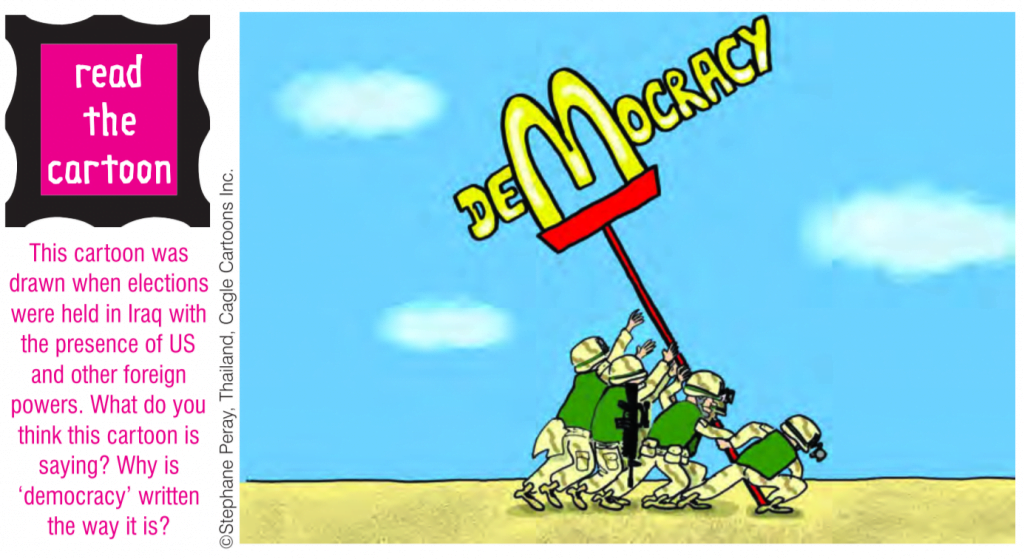
Answer
(i) The military forces (The USA and allied forces) were behind effecting democracy in Iraq. Saddam Hussain ruled Iraq nothing less than a dictator from 1979 to 2003. In 2003 NATO forces occupied Iraq and first multiparty elections were held in 2005 in Iraq.
(ii) ‘M’ stands here to signify the role of army in bringing democracy in Iraq.
Page – 4
Q. Syria is a small West Asian country. The ruling Ba’ath Party and some of its small allies are the only parties allowed in that country.
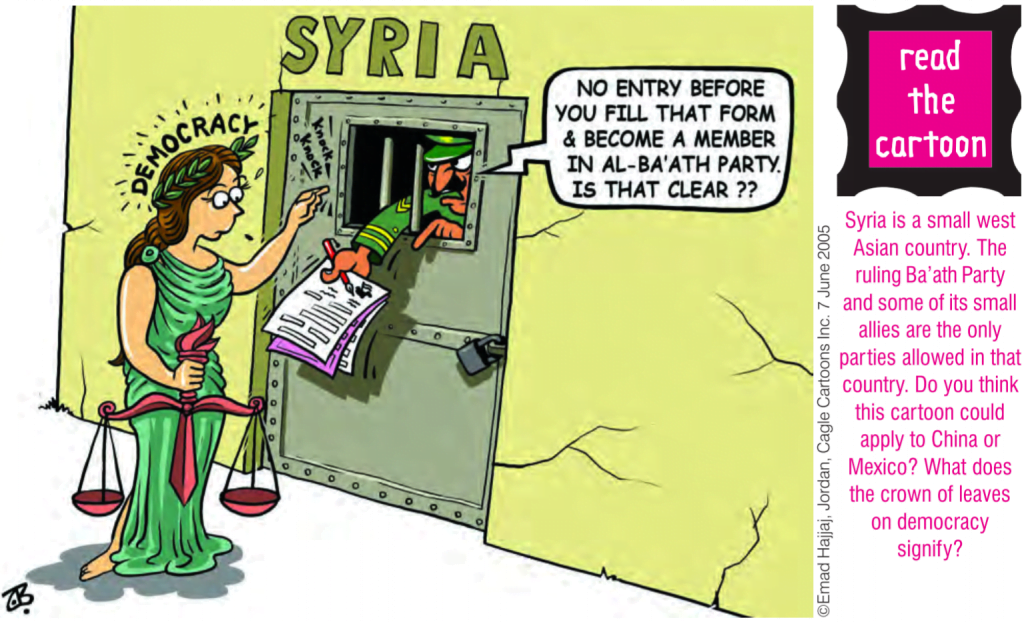
(i) Do you think this cartoon could apply to China or Mexico?
(ii) What does the crown of leaves on democracy signify?
Answer
(i) It applies to both China & Mexico. China cannot be said to be a true democracy as only one-party (Communist Party of China) rules there and candidates are not free to contest elections.
Mexico holds elections regularly in a multiparty system yet there is one dominant party there- the PRI. Until 2000 every election was won by the PRI. The PRI was known to use many dirty tricks to win elections.
(ii) The ‘Crown of leaves’ signify that the symbolic democracy. The constitution speaks of democracy but through democratic process only one-party rules by adopting tactics to keep other oppositions away from becoming the rulers.
The cartoon clearly depicts as how even the allegory of democracy is asked to favour the Baat’h Party in Syria. In such situations true democracy cannot sustain. In the name of democracy only one party will remain in power.
Page-5
Q. This cartoon was drawn in the context of Latin America.

(i) Do you think it applies to the Pakistani situation as well?
(ii) Think of other countries where this could apply?
(iii) Does this happen sometimes in our country as well?
Answers
The cartoon reflects as how the armed forces, be the police, army or hooligans, hijack democracy by force.
(i) This can be applicable to the Pakistan. the democratic government of Nawaz Sharif was toppled through a military coup by Parvez Musharaf. In Pakistan, General Musharraf with the help of army officials controlled the elected representatives. The final power rested with Parvez Musharraf.
(ii) This could be applied in many Latin American countries, Iraq, China, etc.
(iii) In India, incidents of violence and booth capturing by hooligans of politicians were common features during elections especially in northern states of Bihar and Uttar Pradesh and W. Bengal. Now a days the EVMs are used for voting and it has drastically reduced violence and booth capturing incidents.
Q. All this is so remote for me. Is democracy all about rulers and governments? Can we talk about a democratic classroom? Or a democratic family?
Ans. Here ‘remote’ means not accessible or not interested in pursuing or have no relevance (mere matalb ka nahi hai). The government and all associated activities are not understandable by a little child.
The child wants nearby examples of democratic process that he could understand by observing.
His own family or his own classroom matters here. He lives in his family and attends classes and therefore is interested in seeing if democracy applies in these places!
After going through the chapter, you know that democracy can be applied to other spheres of life other than the governments.

Page – 6
Q. This cartoon was titled ‘Building Democracy’ and was first published in a Latin American Publication.

(i) What do money bags signify here?
(ii) Could this cartoon be applied to India?
Answer
(i) A lot of money is spent during elections. Politicians spend huge amount of money in campaigning and even to buy votes. Role of money in effecting elections undermine the very purpose of democracy where a voter freely decided his vote.
(ii) India is no exception and most of our leaders sitting in the Parliament are Millionaires.
Page – 7
Q. This cartoon is about the Iraqi election held after Saddam Hussein’s regime was overthrown. He is shown behind the bars.
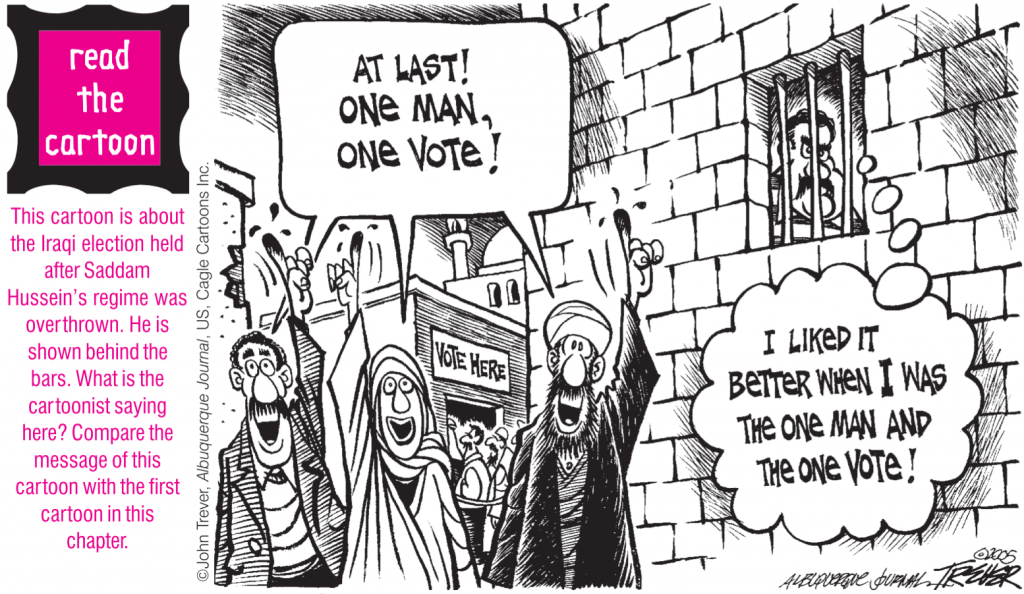
(i) What is the cartoonist saying here?
(ii) Compare the message of this cartoon with the first cartoon in this chapter.
Answers
(i) The cartoon shows how a dictator and how the voters perceive or mean by ‘One Vote One value’.
For the dictator Saddam Hussain – one vote = vote of every person and one man = he himself (Saddam Hussain)
For the people (voters) – one vote = vote of a person and one man = the candidate of his/her choice
(ii) This cartoon is the consequence of the first cartoon showing the US army personnel elevating the process to form a democracy in Iraq. But in this cartoon the message is that the democracy is already installed.

Q. Why talk about Zimbabwe? I read similar reports from many parts of our own country. Why don’t discuss that?
Ans. This cartoon highlights the issue that the popularly elected governments can also be undemocratic and autocratic if they are chosen with a good majority.
Robert Mugabe was a popular leader but he used unfair practices in elections. Opposition party workers were harassed, public protest and demonstration against the government were declared illegal, both print and electronic media were controlled by the government.
In our own country a single party (The Congress Party) ruled for a long time since independence. In such situations the opposition remains ineffective.
Indira Gandhi had imposed ’emergency’ and there by suspending fundamental rights and bringing censorships and many curbs on activities by opposition party leaders. many were put behind jails. Efforts were also made to curtail the powers of ‘Judiciary’ of India.
The situation is not the same now but still the governments are still often accused of adopting unfair means to win elections.
Page – 8
Q. Chinese Government blocked free flow of information on the internet by placing restrictions on popular websites like ‘Google and ‘Yahoo’. The image of tanks and an unarmed student reminds the reader of another major event in recent Chinese history. Find out about that event.

Answer: The cartoon is showing the famous ‘Tank Man’ who stood in the way of tanks moving to dispel and brutally crush the democracy movement by the students. It Reminds us of the Massacre in Tiananmen Square in 1989.
In April 1989, the death of Hu Yao bang, a liberal reformer, caused unrest among students and led to gathering and protests taking place in and around Tiananmen Square in Beijing. It was largely a student run demonstration which called for economic reform, freedom of the press and political liberalisation. The Chinese Government brutally suppressed the movement for which it was internationally condemned. Even today, 4 June 1989 is the date that the Chinese government does not allow any gathering there around Tiananmen Square.
Page – 9
Q. I want to be in Lyngdoh Madam’s class! That sounds democratic classroom. Doesn’t it?
Ans. Madam Lyngdoh allowed students to freely ask questions and discuss the issue of democracy to decide if it is the best form of government for people. The freedom of speech and expression is a powerful component of democracy. Students were asking and responding by expressing their minds and thoughts.
Let we ask and discuss freely before arriving any conclusion or decision. All this happened in Lyngdoh Madam’s class and so the students liked it.
It was just opposite to any class where a teacher dictates and students have to just follow him or her. Such a class would be uninteresting for students as it excludes children participation.

Page – 10
Q. This cartoon is from Brazil, a country that has long experience of dictatorship. It is entitled “The Hidden Side of Dictatorship’
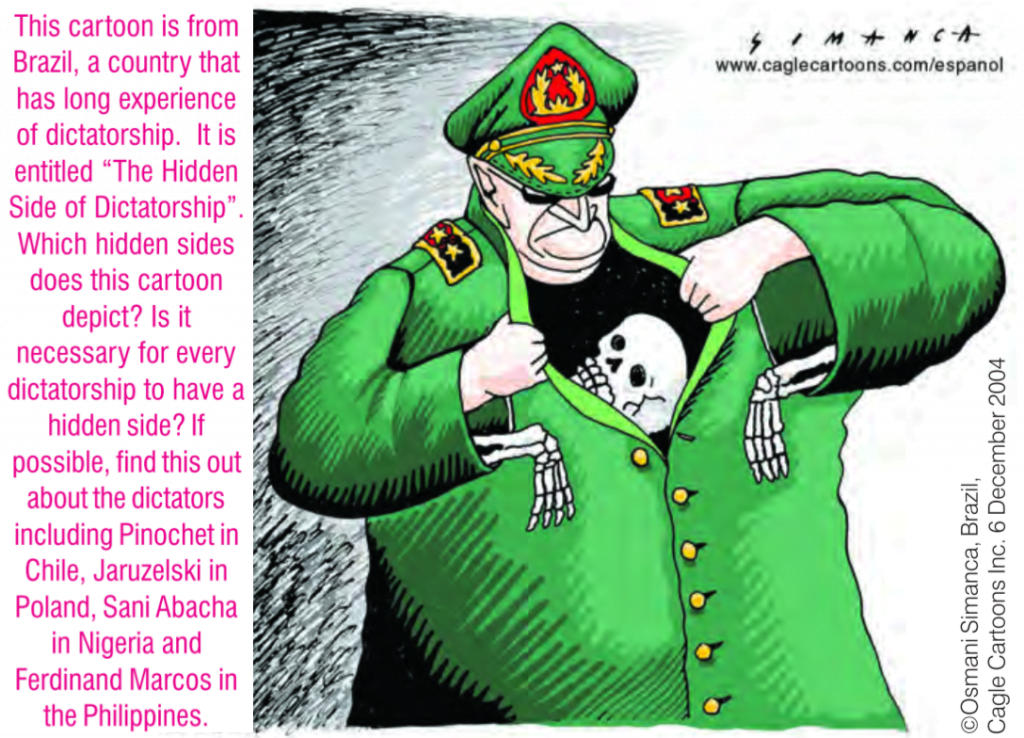
Answers
o(i) ‘The hidden side’ is the brutal side and face of the dictators. It shows the evil character of a dictatorial rule that witnesses mass killings and imprisonments. Many such killings go unreported and remain hidden behind the government propaganda of portraying the dictators like Hitler, Stalin, Mussolini as the saviours and great nationalists for the good of the country.
(ii) We cannot say that it is necessary for every dictatorship to have a hidden side. Because, if the dictator really wants to work for the betterment of people, he does not need to have such a hidden side. Unfortunately, it is also a truth by history that dictators punish their opponents illegally.
(iii)
(a) General Augusto Pinochet – on 11th September, 1973, through a military coup Augusto overthrew the elected government of Salvador Allende. Allende was killed. General Augusto Pinochet became the president of the country and ruled it for the next 17 years.
(b) Wojciech Witold Jaruzelski – He was the DeFacto dictator of Poland from 1981 to 1990. He tried to crush the Solidarity Movement led by Lech Walesa. He imposed Martial Law in 1981 in Poland. He resigned from the power after an agreement called the ‘Polish Round table Agreement’ in 1989 and then democratic elections were held in Poland.
(c) General Sani Abacha – This dictator from army came to power through a military coup in Nigeria. He remained president of Nigeria from 1993 to 1998 till his sudden death. His tenure was ridden with human rights abuses and large-scale corruption. His most brutal act was hanging a social activist Ken-Saro-Wiwa and some other activists. He was so corrupt in amassing wealth that he was listed as the world’s fourth most corrupt leader in the recent history of rulers.
(d) Ferdinand Emmanuel Edralin Marcos – He was the president of the Philippines from 1965 to 1986. He had imposed martial law in 1972 that remained till 1986. His regime was marred by massive corruption, political repression and human rights abuses. In the 2004, Global Transparency Report, Marcos appeared in the list of the world’s corrupt leader. He was said to have amassed between $ 5 billion to $ 10 billion in his 21 years as President of Philippines. He was an example of government robbery by a ruler.
Page – 11

Q. What would have happened if India was not a democracy? Could we have stayed a single nation?
Ans. The answers to this question can be different for different people but we can see the merits of democracy to answer such questions.
An important argument in favour of democracy is, “Democracy provides a method to deal with differences and conflicts.”
India is the most diverse country in the world with different religions, languages, cultures and ethnicity etc. Such a great diversity generates conflicts and chaos. Democracy is considered the best form of government in resolving such conflicts through dialogues and discussions by giving all the right to express their opinions. Everyone is given a say in democracy.
The dignity of every citizen is maintained in a democracy.
Democracy allows to correct its own mistakes.
The above points help in concluding that for India, Democracy is the best form of government in keeping it together as a single nation by accommodating religious, linguistic, social and ethnic diversities. .
Page – 12
Q. This cartoon was published in Canada just before its Parliamentary elections of 2005. Everyone, including the cartoonist, expected the Liberal Party to win once again. When the result came, the Liberal Party lost the elections. In this cartoon an argument against democracy or for democracy?

Answer: The cartoon is mostly in favour of democracy. democracy gives the freedom to judge your rulers and change them if you desire so. The cartoon shows how the cartoonist is examining critically the tenure of the Liberal Party. Ultimately, it is he himself who decides to bring the Liberal party back to power. We can question his decision by a voter is free to vote.
Page – 13
Q. This famous cartoon by RK Laxman comments on the celebrations of the fifty years of independence.
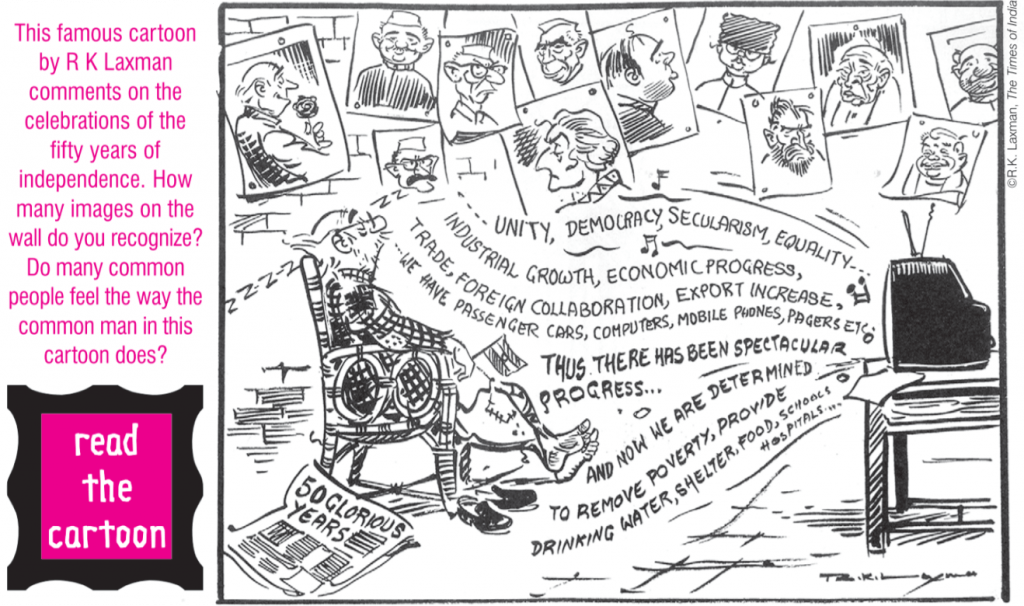
(i) How many images on the wall do you recognise?
(ii) Do many common people feel the way the common man in this cartoon does?
Answers
(i) The images are of the 12 Prime Ministers of India.
- Jawaharlal Nehru
- Lal Bahadur Shastri
- Gulzari Lal Nandu
- Morarji Desai
- Choudhary Charan Singh
- Indira Gandhi
- Rajiv Gandhi
- VP Singh
- Chandra Shekhar
- Narasimhan Rao
- Devegowda and
- A B Vajpayee
(ii) Yes, many common men feel the way the cartoon is showing. He is holding the flag of India but indifferently sleeps before the TV programme telecast on the occasion of 50 years of Independence. The big words like industrial growth, secularism, democracy, economic progress do not attract him. The slogans of poverty alleviation, safe drinking water, food and shelter appear fake for a common man because he feels cheated when finds his own condition not changed much since independence.
Such programmes more are formal than mass oriented.



very nice answers so usefull
Amazing answers helped me alot
VERY USEFUL FOR THE STUDENTS ESPECIALLY NOW….WHEN IN OUR TERM 1 SUCH PICTURE BASED QUESTIONS WILL DEFINITELY BE ASKED….THANK YOU
Very helpful thanku
Really really helpful!Thankyou!
Can you please tell the answer of the question on page 14 top corner?🙏
The Gram Sabha should meet regularly to carry out its functions for the welfare of the people but if the Gram Sabha does not meet that would not be democratic, it would be undemocratic.
wonderful answers they helped a lot
Thanks for this
It was very helpful 🙏💕😌🙏
Thanks, the explanations were helpful for me to figure the meanings of cartoons. The explanation of cartoon on page no. 8 (an unarmed student stood before the tanks) where you gave the demonstration of Massacre in Tiananmen Square was convenient, but you might have noticed Yahoo, Google and Cisco written on the wheels of tanks. What do they mean here?
Thanks for your appreciation of the post on cartoon explanations. China has press censorship and it shows that even media was crushed by the actions of the government and any unfavourable reporting was not allowed.
Hello
This was the helpful butt. Hmm, I was thinking that you can do this in a very easy way also.
Please .
Thanks for reading my comment
Thank you soooo much. This post was really helpful since our teacher did not discuss all these cartoons with us and they are necessary to understand the lesson well!
Thank you for the comment. We have a video also with the explanations. It is now available here.
Can’t tell u how much it helped me.Thank u so much sir.🙏
Thanku very much much…… …I can’t say anything about it……. My annual exam will come. And full course is coming in that way thanks again……… Will you plz. All yr. Do this internal Q’s. Of all ….. Plz…………….. 🙏👍
the indira gandhi part was true
greaat
On pg 8 it is written yahoo google and cisco what does this mean
It means controlling and crushing freedom of speech and expression via internet media. Moreover, it also means that the internet media was bound to present as news what the Chinese govt would ask to show and write.
Thankss
Broo these are these are web sites
Thanku so much sir
thank you sir
i have my exams today and i read this it was very helpful
Thank you to the person who made this , really helped me …tomorrow is my social exam and I wasn’t understanding some cartoons in the book,I read this …it really helped me so, thank you.
oh really
hello
Thank you for solving my problem but do you have any explanation video where I can understand some questions
If you have any questions, you can contact us at WhatsApp 8081370373
Thanks for this effort ….. can I join to help you
thnkssss helpful
So much helpful!!
Thank you fr
nameste
I am veryyyyyyyyyyyyyyy thankful to you for this
Tomorrow is my exam and I had forgot what my teacher had told about these cartoons in class
I was afraid but you came like an angel from god to help me
Once again, thanks a lot
Excellent
So helpful
thank you so much for this wonderful piece of work !!!!!!!!!!!! I was so worried for my exams , until I saw this !
from chennai psbb
It helped me very well as my I am appearing in term 1 examination
Tomorrow is my sst exam
Wish me good luck 🤞 🤞 🤞 🤞
Sir please make videos on class xi NCERT (chemistry)….
Wonderfully explained! Great work
Answers are very lengthy